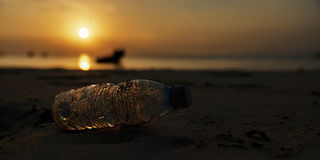The plastic challenge in Kenya: Solutions from the world’s leading conservation organisation
Sponsored by IUCN

A PET water bottle at a beach in Kilifi County, Kenya.
By Peter Manyara
Every day, an average of 2,000 tonnes of plastic objects are imported or produced in Kenya, with 100 tonnes of related wastes ending up in rivers and the Indian Ocean.
From the packaging that keeps ‘dhania’ fresh at your local grocery to plastics used in high-performance applications, to stop using plastics is unimaginable. There is no denying the benefits of plastics in making our lives easier.
More recently, the world has used more plastics because of Covid-19. Before the pandemic, personal protective equipment (PPE) was a phrase confined to hospital corridors and the ‘mjengo’ sector. Today, PPE has become a major environmental issue, adding to an already growing plastics problem.
In 2020, cities globally reported a tripling in plastic waste due to high production of single-use plastics and PPE. In Mombasa County, an increase in waste volumes has been observed, though the absence of a waste management data system hinders proper tracking and analysis. Incineration facilities for treating waste from health facilities have been overwhelmed and part of the waste is ending up in the municipal waste stream.
An analysis published in December 2020 by the International Union for Conservation of Nature (IUCN) through the generous support of the Swedish International Development Cooperation Agency (Sida), and implemented with Kenya’s Ministry of Environment and Forestry and the National Environment Management Authority (NEMA), found low average plastic waste collection, at 27 percent country-wide, based on 2018 data. That is, 125,000 of 506,000 tonnes of total plastic waste was collected towards recycling and disposal.
Some 465,000 tonnes of plastic waste are considered mismanaged, with 37,000 tonnes finding their way into various waterways and the ocean – equivalent to dumping 880 million bottles of two-litre ‘soda’ into the oceans each year. This is huge, as once in the ocean, plastic has far-reaching negative impacts to marine animals and fish, human health and navigational safety.
The analysis observed that a number of commodity plastics used in containers, trays, bottles, jars, and general packaging were major contributors to leakage into the ocean.
Despite the plastics carrier bags ban in 2017, some related trade still exists. Bags tend to have high leakage rates compared to other plastics. The packaging sector accounts for more than 50 percent of total leakage.
Plastics recycling remains low in Kenya, estimated at eight percent of the total plastic waste generated. The Ministry of Environment and Forestry seeks to transition the waste sector from a disposal-driven model to a more circular system encompassing recycling and composting. The various national strategic plans prioritise infrastructure investments, with which there are job opportunities for the unemployed.
Is there an end in sight?
The IUCN analysis identified interventions that could help surmount the plastic waste and pollution scourge. Six interventions are of strategic importance for their high leakage mitigation potential and low environmental and socio-economic trade-offs.
First, as global oil and gas giants plan their future around plastic production, with investments of at least $400 billion in plastics by 2024, Kenya needs to prepare. An urgent intervention for consideration is the establishment of measures to avoid the importation or production of plastic objects that do not benefit from a recycling solution in the country.
Other measures include more frequent waste collection in areas prone to plastic leakage, waste separation at source with increased door-to-door collection, and proper disposal of waste at landfills by private collectors.
Measures to increase capacity for proper waste disposal, such as creation of sanitary landfills, could be pursued. These are engineered sites that permanently contain waste in a setting isolated from the environment.
NEMA requires that waste transportation vehicles obtain licenses and are fit for purpose. Those that operate illegally could be phased out if NEMA fully enforces existing regulations. Where appropriate infrastructure is in place, it is important that critical assets undergo regular maintenance to ensure they can manage waste well.
Looking ahead, there is reason to be optimistic as the country intensifies its leadership in the fight against plastic pollution. We must act now for the sustained health of our children, environment, and the Kenyan economy. Further information on the IUCN analysis can be found at https://bit.ly/2U0JC80.
__________
The writer is the Regional Project Officer, IUCN MARPLASTICCs, Eastern and Southern Africa


